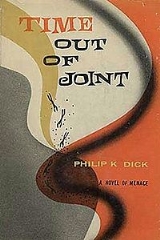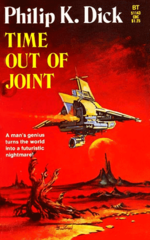
Time out of Joint
Encyclopedia

Novel
A novel is a book of long narrative in literary prose. The genre has historical roots both in the fields of the medieval and early modern romance and in the tradition of the novella. The latter supplied the present generic term in the late 18th century....
by Philip K. Dick
Philip K. Dick
Philip Kindred Dick was an American novelist, short story writer and essayist whose published work is almost entirely in the science fiction genre. Dick explored sociological, political and metaphysical themes in novels dominated by monopolistic corporations, authoritarian governments and altered...
, first published in novel form in the United States
United States
The United States of America is a federal constitutional republic comprising fifty states and a federal district...
in 1959. An abridged
Abridgement
Abridgement or abridgment is a term defined as "shortening" or "condensing" and is most commonly used in reference to the act of reducing a written work, typically a book, into a shorter form...
version was also serialised in the British
United Kingdom
The United Kingdom of Great Britain and Northern IrelandIn the United Kingdom and Dependencies, other languages have been officially recognised as legitimate autochthonous languages under the European Charter for Regional or Minority Languages...
science fiction
Science fiction
Science fiction is a genre of fiction dealing with imaginary but more or less plausible content such as future settings, futuristic science and technology, space travel, aliens, and paranormal abilities...
magazine
Magazine
Magazines, periodicals, glossies or serials are publications, generally published on a regular schedule, containing a variety of articles. They are generally financed by advertising, by a purchase price, by pre-paid magazine subscriptions, or all three...
New Worlds Science Fiction
New Worlds (magazine)
New Worlds was a British science fiction magazine which was first published professionally in 1946. For 25 years it was widely considered the leading science fiction magazine in Britain, publishing 201 issues up to 1971...
in several installments from December 1959 to February 1960, under the title Biography in Time.
The novel epitomizes many of Dick's themes with its concerns about the nature of reality and ordinary people in ordinary lives having the world unravel around them. The title is a reference to the line uttered by Hamlet
Hamlet
The Tragical History of Hamlet, Prince of Denmark, or more simply Hamlet, is a tragedy by William Shakespeare, believed to have been written between 1599 and 1601...
to Horatio after being visited by his father's ghost and learning that his uncle Claudius murdered his father; in short, a shocking supernatural event that fundamentally alters the way Hamlet perceives the state and the universe ("The time is out of joint; O cursed spite!/That ever I was born to set it right!" [I.V.211-2]), much as do several events in the novel.
Plot summary
As the novel opens, its protagonist Ragle Gumm believes that he lives in the year 1959 in a quiet AmericanUnited States
The United States of America is a federal constitutional republic comprising fifty states and a federal district...
suburb. His unusual profession consists of repeatedly winning the cash prize in a local newspaper competition called, "Where Will The Little Green Man Be Next?". Gumm's 1959 has some differences from ours: the Tucker
1948 Tucker Sedan
The 1948 Tucker Sedan or Tucker '48 Sedan was an advanced automobile conceived by Preston Tucker and briefly produced in Chicago in 1948...
car is in production, AM/FM radios are scarce to non-existent and Marilyn Monroe is a complete unknown. As the novel opens, strange things begin to happen to Gumm. A soft-drink stand disappears, replaced by a small slip of paper with the words "SOFT-DRINK STAND" printed on it in block letters. Intriguing little pieces of the real 1959 turn up: a magazine article on Marilyn Monroe
Marilyn Monroe
Marilyn Monroe was an American actress, singer, model and showgirl who became a major sex symbol, starring in a number of commercially successful motion pictures during the 1950s....
, a telephone book with non-operational exchanges listed and radios hidden away in someone else's house. People with no apparent connection to Gumm, to include military pilots using aircraft transceivers, refer to him by name. Few other characters notice these or experience similar anomalies; the sole exception is Gumm's supposed brother-in-law, Victor "Vic" Nielson, in whom he confides. A neighborhood woman, Mrs. Keitelbein, invites him to a Civil Defense class where he sees a model of a futuristic underground military factory. He has the unshakeable feeling he's been inside that building many times before.
Confusion gradually mounts for Gumm. His neighbor Bill Black knows far more about these events than he admits, and, observing this, begins worrying: "Suppose Ragle is becoming sane again?" In fact, Gumm does become sane, and the deception surrounding him (erected to protect and exploit him) begins to unravel.
Ragle tries to escape the town and is turned back by kafkaesque obstructions. He sees a magazine with himself on the cover, in a military uniform, at the factory depicted in the model. He tries a second time to escape, this time with Vic, and succeeds. He learns that his idyllic town is a constructed reality designed to protect him from the frightening fact that he lives on a then-future Earth (circa 1998) that is at war with its colonists on the Moon who are fighting for a permanent Lunar habitation that is politically independent of Earth as well.
Gumm has a unique ability to predict where the colonists' nuclear strikes will be aimed. Previously Gumm did this work for the military, but then he defected to the colonists' side and planned to secretly emigrate to the Moon. But before this could happen he began retreating into a fantasy world based largely upon the relatively idyllic surroundings of his extreme youth. He was no longer able to shoulder the awesome responsibility of being the Earth's lone protector from Lunar-launched H-Bomb attacks. The fake town was thereby created in Ragle Gumm's mental image to accommodate his dementia so that he would continue predicting missile strikes in the guise of submitting entries to a harmless newspaper contest and without the ethical qualms involved with being on the "wrong" side of a civil war.
When Gumm finally remembers his true history he decides to emigrate to the Moon after all because he feels that exploration and migration, being as they are basic human impulses, should never be denied a people by any national or planetary government. Vic rejects this belief, referring to the colonists essentially as aggressors and terrorists, and returns to the town. The book ends with some hope for peace, because the colonists are more willing to negotiate than the Earth government has been telling its citizens.
See also
- Simulated realitySimulated realitySimulated reality is the proposition that reality could be simulated—perhaps by computer simulation—to a degree indistinguishable from "true" reality. It could contain conscious minds which may or may not be fully aware that they are living inside a simulation....
- Ding an sich, a concept mentioned in the story.
- Ender's GameEnder's GameEnder's Game is a science fiction novel by American author Orson Scott Card. The book originated as the short story "Ender's Game", published in the August 1977 issue of Analog Science Fiction and Fact. Elaborating on characters and plot lines depicted in the novel, Card later wrote additional...
, a 19851985 in literatureThe year 1985 in literature involved some significant events and new books.-New books:*Isaac Asimov - Robots and Empire*Margaret Atwood - The Handmaid's Tale*Jean M. Auel - The Mammoth Hunters*Iain Banks - Walking on Glass...
novel with a similar premise
Criticism
- DiTommaso, Lorenzo, "A logos or Two Concerning the logoz of Umberto Rossi and Philip K. Dick's Time Out of Joint", Extrapolation, 39:4, 1998, pp. 285–98.
- Potin, Yves, "Four Levels of Reality in Philip K. Dick's Time Out of Joint", Extrapolation 39:2, 1998, pp. 148–165.
- Rossi, Umberto, "Just a Bunch of Words: The Image of the Secluded Family and the Problem of logos in P.K. Dick's Time out of Joint", Extrapolation, Vol. 37 No. 3, Fall 1996.
- Rossi, Umberto, “The Harmless Yank Hobby: Maps, Games, Missiles and Sundry Paranoias in Time Out of Joint and Gravity’s Rainbow”, Pynchon Notes #52-53, Spring-Fall 2003, pp. 106–123

